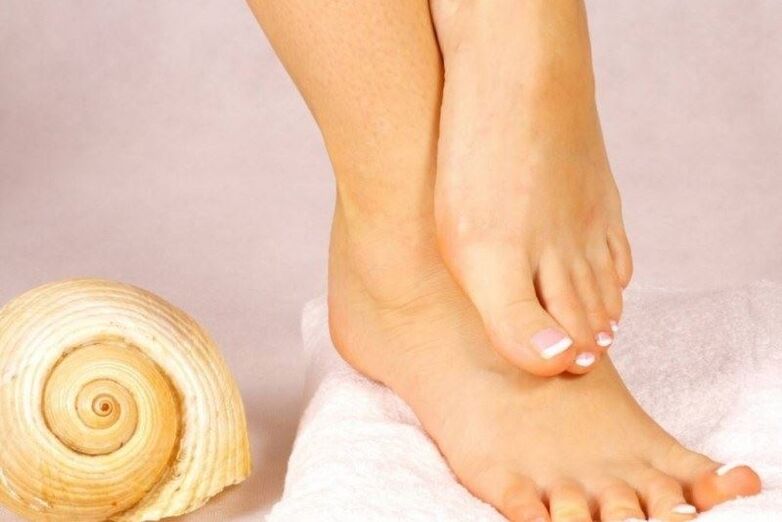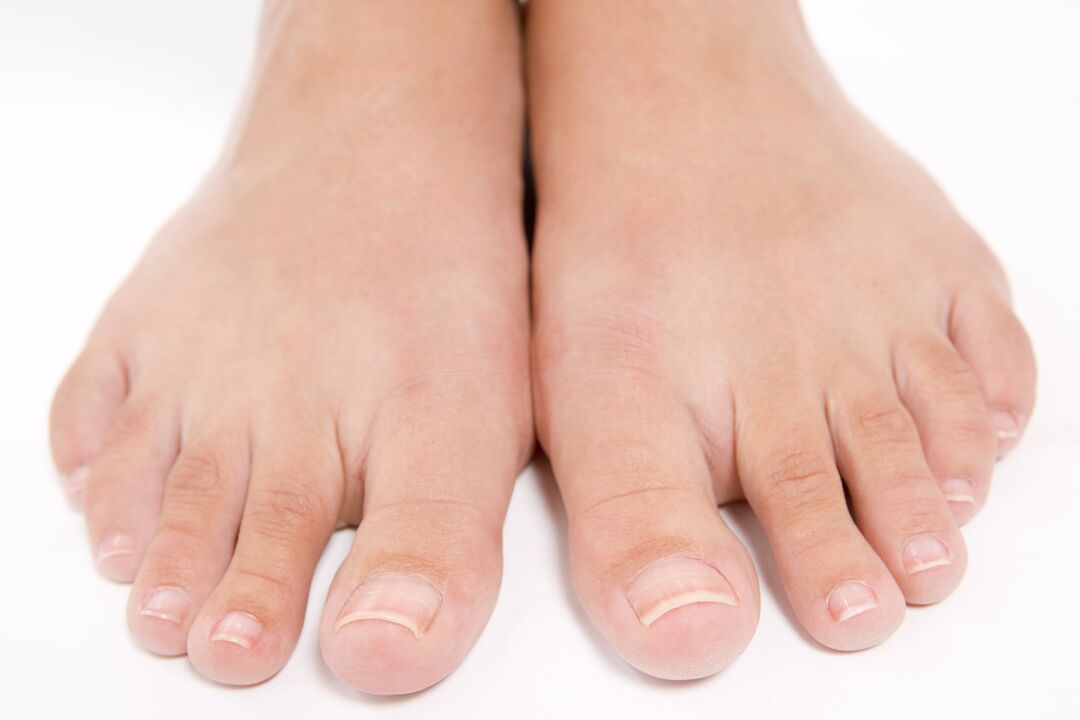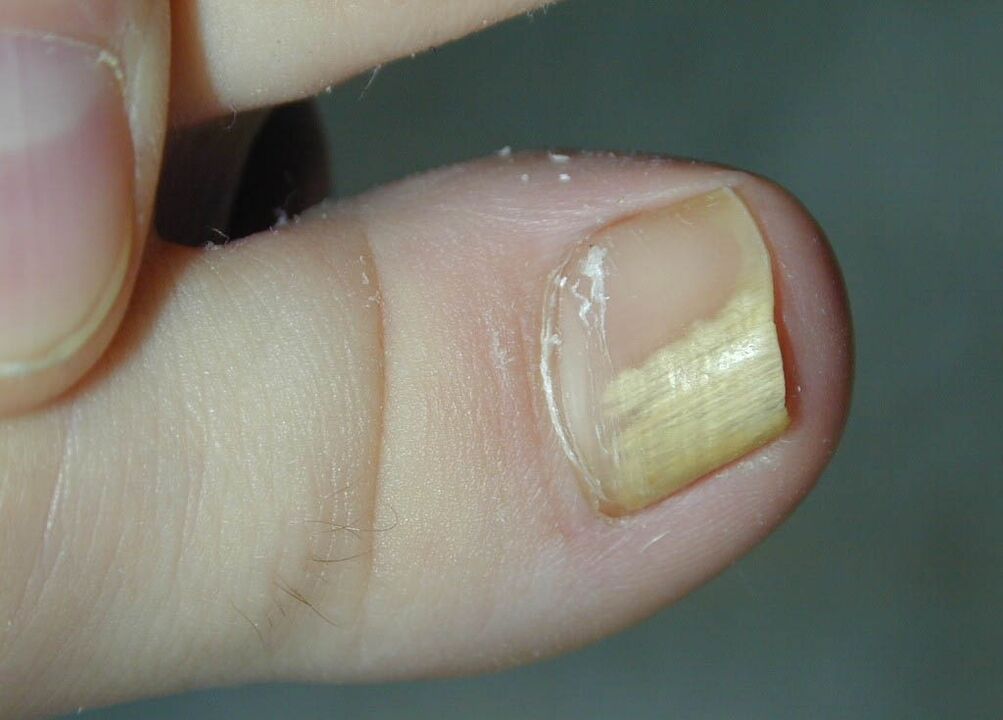Foot fungus is an infectious disease that is transmitted from person to person. Foot fungus is the most common type of fungus in adults. Women and men and even children are sick of it.
Mycosis (fungus) is a skin disease caused by parasitic fungi. It can easily be caught by contact with an infected person or through objects and things that the patient has come into contact with. Fungi are very fond of warm and humid environments, which is why public places such as saunas, baths, water parks, beaches and swimming pools are considered potentially dangerous. English doctors call this disease "a symptom of athlete's foot", because athletes use closed, poorly breathable shoes, inside which moisture accumulates.
Mycoses are very insidious, despite the apparent simplicity of the disease, they are difficult to cure and tend to relapse.
Recognize as soon as possible
Treatment of mycosis is a rather long and complex process, so it is important to find out as soon as possible what the fungus looks like on the legs, the reasons for its appearance and start taking action. The fungus usually first appears between the toes. Then, if left untreated, the infection invades the nail plate, resulting in the destruction of the nail. If the cause is an infection in a pedicure salon, the disease begins with the nail plates.
Often, after infection, the fungus makes itself felt quite early, and you immediately realize that "something" is wrong. But the manifestations of the fungus on the legs can have a different character: hidden or pronounced. That is why it is necessary to understand how the fungus begins on the legs, what it looks like and how to recognize it.

What are the first symptoms of toenail fungus?
After contact with the skin, the fungus on the legs goes through an incubation period (depending on the person's immunity, 3-14 days), at which time the disease does not manifest itself.
The first symptoms that should make you think of a visit to a dermatologist can be:
- The skin of the legs appears reddened or covered with spots, itching, burning. This causes terrible discomfort, you constantly want to scratch your legs. This sign of foot fungus is noted in 99% of cases of the disease.
- Thickening or roughness of the skin of the feet. Often this sign of toenail fungus is overlooked because it looks like a callus or corns.
- Bubbles of liquid on the affected areas of the skin. If the patient combs them, an infection can get into them, then the blisters burst, fester and erode, ulcers, abscesses appear on the skin.
- Cracks appear between the toes. Most often, the defeat of the fungus of the foot begins in the spaces between the fingers (between the first and second or fourth and fifth). Cracks can cause discomfort or even pain.
- If timely treatment is not started, the skin on the legs becomes rough and takes on the appearance of scales, while excessively dry skin on the legs is observed - a sure sign that you have a fungus. Later, the affected areas of the skin (toes, heel, foot) appear softened, covered with a whitish coating.
- The feet smell bad.
- The skin on the legs looks pathologically shiny.
- Edema appears. This suggests that you have a chronic fungus on your feet.

Interdigital infection
The onset of interdigital infection begins with the skin between the toes looking too pale, soft and moist, and may show symptoms such as burning skin and mild foot odor. If the infection is not treated, a bacterial infection is added to the fungal infection. And this, in turn, leads to the appearance of bad foot odor.
Interdigital infection can be complicated even with treatment. Cracks and peeling develop until the skin becomes very dense and thick.
If no action has been taken, the infection passes to the nail plates, which contributes to their rejection and falling off.
Vesicular infection
A less common type of fungal leg infection. It usually begins with the fact that under the skin of the legs suddenly appear areas filled with liquid contents, resembling blisters. Most commonly, blisters develop on the back of the foot, although they can also appear between the toes or in the heel area, as well as on the ball of the foot.
This type of disease can develop after the primary infection. In addition, a secondary infection can affect both the same areas as the first (on the skin of the legs) and other parts of the body. The seed coats in these cases, as a rule, begin to peel.
moccasin-like mushroom
This fungus begins with the manifestation of pain in the foot. Then, during the disease, the skin on the sole gradually thickens, and then begins to crack.
Fungal diseases in this form often affect the nails, which then thicken, begin to crumble or even completely fall off.

Manifestation of symptoms and type of fungus
The manifestations of the symptoms of nail fungus depend on the type, as well as the degree and depth of the fungal infection.
Symptoms of nail fungus include the following manifestations:
- the nail looks cloudy, loses its shine;
- the color of the nail changes from yellow to black;
- the surface looks rough, and the nail itself begins to crumble;
- the nail is pathologically thickened or, on the contrary, extremely thinned;
- there is a painful curvature of the nail plate;
- the cuticle around the diseased nail is unaffected by the fungus or appears slightly inflamed.
With fungal diseases, it becomes very difficult, if not impossible, to cut the nails without preliminary preparation, since they are too thick. If the thickened nail presses against the skin underneath, pain may occur.
A fungal infection is a very complex disease, it is not easy to remove it, especially if the disease is running. Therefore, if you notice that "something" is going on, you should immediately consult a doctor, since only the early stages of this disease are easier and faster to treat.
Urgent to the doctor!
If you notice the signs of foot fungus in yourself, don't expect it to go away on its own. The longer you have foot fungus, the harder it is to cure and the worse it is for the whole body. Prolonged mycosis can cause weakening of immunity, allergic reactions and exacerbation of chronic diseases. That is why at the first suspicions contact a dermatologist or mycologist. The doctor will conduct an examination, determine the degree of the disease, the structure of the affected skin or nail, and take tissue samples for analysis. Thus, the doctor will determine the presence of a fungal infection on the legs, its type and prescribe the appropriate treatment, tablets, syrups or injections (in the most difficult cases).
So, if you have very sore soles of your feet, maybe an old fungus has taken over, see a doctor immediately. It is very important to begin immediate treatment of the fungus in order to recover from an unpleasant illness yourself and protect others.
The initial stage of nail fungus
Onychomycosis is a common pathology in which pathogenic microorganisms multiply in the depths of the nails and adjacent tissues. As a result, the nail plate gradually deforms. The initial stage of nail fungus can be effectively treated.
Subject to recommendations, patients recover within a few months. Other preventative measures will help keep your nails healthy.
How is the initial phase
Symptoms in the early stages of the disease are the same on the arms and legs. At first, the nail plate changes its shade. From pink, it becomes yellowish and dull, sometimes turning to a grayish color. It is possible to change the structure of the plate - tubercles or other swellings appear on it.
In the future, longitudinal stripes, yellow spots or spots are visible on the nails. The plate begins to expand and thicken, at the same time it becomes brittle. The skin next to the nail also suffers from fungus, becomes inflamed and reddened. Most often, spore infection occurs on the legs, first of all, onychomycosis develops on the big toe (but there are exceptions).
At the initial stage of the disease, the fungus affects only one side of the nail plate. There are the following types of lesions:
- distal form - the upper part of the nail is affected;
- side view - the fungus is located on the sides of the plate;
- superficial lesion - the surface of the plaque suffers;
- proximal form - the periungual roller is affected.
In the photo you can see the appearance of the nails, at the initial stage of onychomycosis.
How is the treatment going
If you suspect onychomycosis, you should seek the help of a dermatologist. The doctor will examine the nails, if necessary, take a scraping for the presence of mycelial fungi. After making a diagnosis, the doctor will tell you how to treat the disease.
Local therapy is aimed at eliminating inflammation, restoring blood supply to the diseased nail. Preparations can take the form of varnishes, sprays, lotions. They are applied to the affected nail plates, to the skin around them.
The best known antifungal agents:
- varnish. They are applied several times a week. The active substances penetrate deep into the nail. They are among the most potent antifungal agents;
- cream. Designed for the treatment of skin and periungual ridges. They are treated with healthy nails to protect them from the penetration of the fungus;
- drops. Medicines are applied to diseased nails. 1 to 2 drops;
- lotion kills fungus on the surface layers of the nail.
Sprays are used as a practical prophylactic against onychomycosis. They treat the soles of the feet, fingers and shoes.
In addition to local treatment, doctors perform systemic therapy. The patient takes antifungal tablets or capsules. They kill the infection and help to quickly cope with pathology.
Other treatments
- Laser therapy - the impact on microorganisms of laser beams. In the early stages of the disease, it is enough for the patient to undergo only three to four procedures. The method not only kills pathogenic fungi, but also improves blood circulation.
- Ozone therapy - an injection of ozone is injected into the skin near the affected nail plates. Cells are saturated with ozone, resist infection. Immunity increases in the body. But this procedure is effective only in the early stages of the disease.
Both methods only supplement the traditional treatment at the initial stage. They are prescribed along with pills and topical treatments.
How traditional medicine can help
To cure the fungus in the early stages will help the advice of traditional healers. Their advantage is that natural products are used, without chemical additives.
The main methods of treatment include:
- Apple cider vinegar - dilute it in equal proportions with warm water. Take a bath, take it for 15 minutes. Do the procedure daily until all symptoms disappear. But apple cider vinegar is only suitable for treating foot fungus.
- In the early stages of onychomycosis, ordinary hydrogen peroxide actively suppresses the fungus. Dip your fingers in water with the addition of soda (one tablespoon per two liters of hot water). Dip cotton balls in peroxide, place them on the affected nails and secure them with a bandage. Wear the compress for at least 40 minutes.
- Tea tree essential oil helps in treatment. This antiseptic is used as a complementary remedy for all degrees of the disease. Rub a few drops of the extract into the affected nail plates, do not wash off the oil. Carry out treatment from 2 weeks until complete healing. But this method is not suitable for children and women in an interesting position.
- Soda baths help fight fungus. Dilute a tablespoon of soda and a few drops of liquid soap (or grated laundry soap) in two liters of hot water. Dip your hands or feet into the solution. Keep them for 15-20 minutes. Then treat your nails with medication or antiseptics.
- Regular treatment of nail plates with iodine helps get rid of onychomycosis. Every day lubricate the nail with iodine solution. You can make antiseptic baths - add a bottle of iodine to three liters of water, keep your feet or hands in it for 10 minutes.
After baths and other folk remedies, nails, fingers and the skin between the fingers should be thoroughly dried. Then put on your socks.
What are the complications
If the problem is ignored, the fungus will not go away on its own, microorganisms will constantly multiply.
This has serious consequences:
- complete deformation of the nail plate;
- the disease becomes chronic;
- the infection will spread to healthy nail plates;
- the immune system will decrease, a favorable environment will be created for the development of other viral or bacterial infections.
Prevention rules
Treatment of onychomycosis is long and requires financial investments. Preventive measures will help protect you from the fungus, although they cannot be called a panacea for the disease.
These include:
- don't wear other people's things or shoes. As a last resort, treat them with antifungals;
- use only personal hygiene products - napkins, scissors, nail file;
- in public places (saunas, baths or swimming pools) walk only with rubber shoes;
- don't try on new shoes in a barefoot store or market, wear socks.
Relapse is a common phenomenon. It is observed in 6-8% of cases from the number of people recovered.
Conclusion
Fungal diseases affect people, regardless of age and gender. Not everyone knows what the fungus looks like in the early stages and does not attach importance to changes in the nails. Treatment at the initial stage of the disease is easy, new healthy nails grow in place of the affected nails.
Therapy is prescribed by a dermatologist, in addition to local methods, comprehensive treatment with antimycotic drugs is carried out. In the early stages of onychomycosis, in addition to traditional medicines, folk recipes can also be used.
















